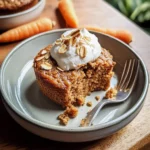Mornings can be hectic, and finding time to whip up a nutritious and exciting breakfast can feel like a luxury. For years, I’ve been stuck in a breakfast rut, cycling through the same old cereals and toast. That was until I stumbled upon the magic of baked oats, and specifically, this Single-Serving Carrot Cake Baked Oats recipe. Let me tell you, this isn’t just your average oatmeal. It’s a game-changer! The first time I made it, the aroma alone was intoxicating – warm spices and sweet carrots filling my kitchen. The texture is incredible – fluffy and cake-like, yet still wholesome and satisfying. My family, even the picky eaters, devoured it! They loved the subtle sweetness and the hint of spice, and the cream cheese filling? Pure genius! It adds that decadent touch that truly elevates this dish from breakfast to a delightful treat you can enjoy any time of day. If you’re looking for a breakfast that feels indulgent but is secretly packed with goodness, this Single-Serving Carrot Cake Baked Oats is about to become your new obsession. Get ready to transform your mornings!
Ingredients: The Building Blocks of Your Carrot Cake Oats
This recipe uses simple, wholesome ingredients that you likely already have in your pantry and refrigerator. Each ingredient plays a vital role in creating the perfect texture and flavor profile of our single-serving carrot cake baked oats. Let’s break down each component:
For the Baked Oats Base:
- ½ Cup Rolled Oats: Rolled oats are the star of the show, providing a hearty base and that classic oatmeal texture. They are different from instant oats or steel-cut oats and are the ideal choice for baked oats.
- Why Rolled Oats? Rolled oats, also known as old-fashioned oats, are partially cooked and then rolled flat. This process makes them cook faster than steel-cut oats but slower than instant oats, resulting in a perfect texture for baking. They absorb liquid beautifully, creating a soft and fluffy interior while maintaining a bit of chewiness.
- Gluten-Free Goodness: Oats are naturally gluten-free, making this recipe suitable for those with gluten sensitivities. However, it’s important to ensure you are using certified gluten-free rolled oats, as some oats can be processed in facilities that also handle wheat.
- Nutritional Powerhouse: Rolled oats are packed with fiber, which aids in digestion and keeps you feeling full and satisfied for longer. They are also a good source of complex carbohydrates for sustained energy and contain essential vitamins and minerals like manganese, phosphorus, and magnesium.
- ¼ Cup Carrots, Finely Shredded: Carrots are the namesake ingredient, bringing sweetness, moisture, and vibrant color to our baked oats. Finely shredding them is key to ensure they cook evenly and blend seamlessly into the batter.
- Sweet and Nutritious: Carrots are naturally sweet, reducing the need for excessive added sugars. They are also an excellent source of beta-carotene, which the body converts to Vitamin A, crucial for vision, immune function, and skin health. They also contribute fiber and antioxidants.
- Preparation Tips: Use pre-shredded carrots for convenience or shred your own using a box grater or food processor. Ensure they are finely shredded to avoid large chunks in your baked oats.
- ½ Cup Milk of Choice: Milk adds moisture and creaminess to the baked oats. You can use any type of milk you prefer, making this recipe easily adaptable to dietary needs and preferences.
- Dairy Milk: Cow’s milk provides a classic creamy texture and adds protein and calcium. Whole milk will result in a richer flavor, while skim milk is a lighter option.
- Non-Dairy Milk Alternatives: For vegan or dairy-free options, almond milk, soy milk, oat milk, coconut milk (light or from a carton, not canned), or cashew milk all work wonderfully. Each will impart a slightly different flavor and texture. Oat milk is particularly creamy and complements the oats beautifully. Almond milk is lower in calories, while soy milk is higher in protein. Coconut milk adds a subtle sweetness. Experiment to find your favorite!
- 1 Teaspoon Vanilla Extract: Vanilla extract enhances the overall flavor profile, adding warmth and sweetness that complements the cinnamon and carrot.
- Pure vs. Imitation: Pure vanilla extract is made from real vanilla beans and offers a richer, more complex flavor compared to imitation vanilla. While imitation vanilla is a budget-friendly option, pure vanilla extract will elevate the taste of your baked oats.
- Vanilla Bean Paste: For an even more intense vanilla flavor, you can substitute vanilla extract with half a teaspoon of vanilla bean paste.
- 2 Tablespoons Maple Syrup: Maple syrup is a natural sweetener that adds a delicious caramel-like flavor and moisture to the baked oats.
- Pure Maple Syrup is Best: Opt for pure maple syrup (Grade A or Grade B) rather than pancake syrup, which is often made with corn syrup and artificial flavors. Pure maple syrup is a natural sweetener with a lower glycemic index than refined sugar and contains antioxidants.
- Alternative Sweeteners: If you don’t have maple syrup, you can substitute with other liquid sweeteners like honey, agave nectar, or brown rice syrup. You can also use granulated sweeteners like brown sugar or coconut sugar, but you may need to adjust the liquid slightly if using granulated sweeteners to maintain the desired batter consistency.
- ½ Teaspoon Cinnamon: Cinnamon is the quintessential spice for carrot cake, adding warmth, spice, and that signature carrot cake aroma.
- Spice it Up: Cinnamon is not only delicious but also boasts potential health benefits, including anti-inflammatory and antioxidant properties.
- Freshness Matters: For the best flavor, use fresh cinnamon. Ground spices lose their potency over time, so replace them every 6-12 months.
- ½ Teaspoon Baking Powder: Baking powder is a leavening agent that helps the baked oats rise and become light and fluffy, creating that cake-like texture we’re aiming for.
- Double-Acting Baking Powder: Most baking powders are double-acting, meaning they react twice – once when mixed with liquid and again when heated. This ensures a good rise during baking.
- Check Expiration Date: Baking powder can lose its effectiveness over time, so check the expiration date to ensure it’s still active.
- 1 Pinch Sea Salt: A pinch of sea salt might seem insignificant, but it plays a crucial role in enhancing the flavors of all the other ingredients, particularly the sweetness and spice.
- Flavor Enhancer: Salt balances the sweetness and brings out the nuances of the other flavors, preventing the baked oats from tasting flat.
- Types of Salt: Sea salt, kosher salt, or even regular table salt will work. If using table salt, use slightly less as it is more concentrated.
For the Optional Add-Ins:
- 1 Tablespoon Chopped Walnuts: Walnuts add a delightful crunch and nutty flavor that complements the carrot cake theme.
- Nutty Goodness: Walnuts are a good source of healthy fats, protein, and antioxidants.
- Other Nut Options: Pecans, almonds, or even chopped hazelnuts would also be delicious alternatives.
- Nut-Free Option: If you have nut allergies, you can omit the nuts or substitute with seeds like pumpkin seeds or sunflower seeds for a similar crunch.
- 1 Tablespoon Raisins: Raisins contribute sweetness and chewiness, adding a classic carrot cake element.
- Sweet Chews: Raisins are a good source of fiber and natural sugars.
- Alternative Dried Fruits: Chopped dates, dried cranberries, or even chopped dried apricots would also work well.
- Soaking for Plumpness: For extra plump and juicy raisins, you can soak them in warm water for 10-15 minutes before adding them to the batter.
- 1-2 Tablespoons Protein Powder of Choice: Protein powder is an optional addition to boost the protein content of your baked oats, making it even more satisfying and keeping you full for longer.
- Whey, Plant-Based, or Casein: You can use whey protein, plant-based protein powder (like pea, soy, or brown rice protein), or casein protein. Choose a flavor that complements carrot cake, such as vanilla, cinnamon, or even unflavored.
- Adjust Liquid if Needed: Protein powder can absorb liquid, so you may need to add a tablespoon or two more milk to the batter to maintain the desired consistency, especially if using a thicker protein powder.
For the Cream Cheese Filling:
- 2 Tablespoons Cream Cheese: Cream cheese provides that signature tangy and creamy flavor that mimics cream cheese frosting in classic carrot cake. Both dairy and non-dairy cream cheese work well.
- Dairy Cream Cheese: Full-fat or reduced-fat cream cheese will both work. Full-fat will be richer and creamier, while reduced-fat is a lighter option.
- Non-Dairy Cream Cheese: Vegan cream cheese alternatives made from cashew, almond, or coconut are readily available and work beautifully in this recipe. Ensure it’s a block-style cream cheese for the best texture.
- Softened for Smoothness: Ensure your cream cheese is softened to room temperature for easier mixing and a smoother filling.
- 1 Teaspoon Maple Syrup or 2 Teaspoons of Powdered Sugar: A touch of sweetener is added to the cream cheese to balance the tanginess and create a slightly sweet filling.
- Maple Syrup for Natural Sweetness: Maple syrup adds a subtle caramel-like sweetness that complements the carrot cake flavors.
- Powdered Sugar for Classic Sweetness: Powdered sugar (also known as confectioners’ sugar) creates a sweeter and slightly more frosting-like filling.
- Sweetness Adjustment: Adjust the amount of sweetener to your preference. Taste the cream cheese filling and add more sweetener if desired.
Instructions: Baking Your Single-Serving Carrot Cake Oats to Perfection
Follow these step-by-step instructions to create your delicious single-serving carrot cake baked oats:
- Preheat Your Oven: Begin by preheating your oven to 350°F (175°C). This ensures the oven is at the correct temperature when you place your ramekin inside, promoting even baking.
- Accurate Oven Temperature: Using an oven thermometer can help ensure your oven temperature is accurate, as oven temperatures can sometimes vary.
- Blend the Baked Oats Base: In a blender, combine all the ingredients for the baked oats base: rolled oats, finely shredded carrots, milk of choice, vanilla extract, maple syrup, cinnamon, baking powder, and sea salt. Add any optional add-ins like chopped walnuts, raisins, or protein powder at this stage as well.
- Blending for Texture: Blend for about 30-40 seconds, or until the mixture is mostly smooth but still retains some texture. You don’t want to over-blend into a completely smooth puree; a little bit of oat texture is desirable for baked oats.
- Blender Types: A regular blender or an immersion blender will both work. If using an immersion blender, use a deep bowl or jar to prevent splattering.
- Prepare Your Ramekin: Grease a 3-4 inch ramekin generously with oil or butter. This prevents the baked oats from sticking to the ramekin and makes it easier to remove after baking.
- Greasing Options: Use cooking spray, coconut oil, melted butter, or olive oil to grease the ramekin. Ensure you grease the bottom and sides thoroughly.
- Ramekin Size: A 3-4 inch ramekin is ideal for a single serving. If using a larger ramekin, the baking time may be slightly shorter.
- Pour Batter and Prepare Cream Cheese Filling: Pour about ¾ of the blended baked oats batter into the greased ramekin. Set the ramekin aside while you prepare the cream cheese filling.
- Reserving Batter: Reserving a portion of the batter allows you to create a layered effect with the cream cheese filling.
- Make the Cream Cheese Filling: In a small bowl, combine the softened cream cheese and maple syrup (or powdered sugar). Mix well until fully combined and smooth.
- Softened Cream Cheese is Key: Using softened cream cheese is crucial for a smooth and lump-free filling. If your cream cheese is cold, microwave it for a few seconds or let it sit at room temperature for a while.
- Assemble and Layer: Place a dollop of the cream cheese mixture into the center of the ramekin on top of the baked oats batter. Then, pour the remaining baked oats mixture over the cream cheese filling, filling the ramekin to the top.
- Cream Cheese Placement: Placing the cream cheese filling in the center ensures it will be a delightful surprise when you dig into your baked oats.
- Filling to the Top: Don’t worry about filling the ramekin to the top; the oats will rise slightly but not overflow.
- Bake: Transfer the ramekin to the preheated oven and bake for about 25 minutes, or until the top is golden brown and a toothpick inserted into the center comes out clean (or with moist crumbs, as baked oats are meant to be slightly moist).
- Baking Time Variation: Baking time may vary slightly depending on your oven and the size of your ramekin. Start checking for doneness around 20 minutes and adjust baking time accordingly.
- Golden Brown Top: The top should be nicely golden brown, indicating that the baked oats are cooked through.
- Toothpick Test: The toothpick test is a good indicator of doneness. Insert a toothpick into the center; it should come out clean or with moist crumbs. Avoid overbaking, as this can make the oats dry.
- Cool and Serve: Once baked, remove the ramekin from the oven and allow it to cool slightly before serving. The baked oats will be very hot right out of the oven.
- Cooling Time: Allowing it to cool for 5-10 minutes makes it easier to handle and prevents burning your mouth.
- Serving Options: Enjoy your single-serving carrot cake baked oats warm, or let it cool completely and enjoy it at room temperature.
- Enjoy! Serve and savor your delicious and healthy single-serving carrot cake baked oats!
Nutrition Facts: Fueling Your Body the Delicious Way
(Please note: Nutritional information is an estimate and can vary based on specific ingredients and brands used.)
Serving Size: 1 Single-Serving Ramekin
Approximate Calories per Serving: 350-450 calories (depending on milk choice, add-ins, and protein powder)
Approximate Macronutrient Breakdown (without protein powder):
- Protein: 10-15 grams
- Fat: 15-20 grams (depending on milk and cream cheese choice)
- Carbohydrates: 40-50 grams (including sugars from maple syrup, carrots, and raisins)
- Fiber: 5-8 grams
Key Nutritional Highlights:
- High in Fiber: Thanks to the rolled oats and carrots, this breakfast is a good source of dietary fiber, promoting digestive health and satiety.
- Good Source of Protein: Oats and milk contribute protein, and adding protein powder further boosts the protein content, supporting muscle building and repair.
- Healthy Fats: Walnuts and dairy or non-dairy cream cheese provide healthy fats, which are important for hormone production, brain function, and nutrient absorption.
- Vitamins and Minerals: Carrots are rich in Vitamin A, and oats provide essential minerals like manganese and magnesium.
- Relatively Low in Added Sugar: Maple syrup is a natural sweetener, and the amount used is moderate, making this a healthier option compared to many commercially prepared breakfast pastries or sugary cereals.
Preparation Time: Quick and Easy Breakfast Delight
- Prep Time: 10 minutes (including shredding carrots and blending)
- Cook Time: 25 minutes
- Total Time: 35 minutes
This single-serving carrot cake baked oats recipe is surprisingly quick and easy to prepare, making it perfect for busy mornings or a satisfying anytime snack. Most of the time is hands-off baking time, allowing you to multitask while your delicious breakfast is cooking.
How to Serve Your Carrot Cake Baked Oats: Endless Delicious Possibilities
Enjoy your single-serving carrot cake baked oats in a variety of ways! Here are some serving suggestions:
- Warm and Cozy: Serve it warm straight from the oven for a comforting and satisfying breakfast or brunch.
- Room Temperature Treat: It’s also delicious at room temperature, making it a great make-ahead breakfast or snack to pack for work or school.
- With a Dollop of Yogurt: Top with a dollop of Greek yogurt, coconut yogurt, or regular yogurt for extra creaminess and protein.
- Fresh Fruit Toppings: Add fresh berries (strawberries, blueberries, raspberries), sliced bananas, or diced apples for added sweetness, vitamins, and texture.
- Nut Butter Drizzle: Drizzle with almond butter, peanut butter, cashew butter, or sunflower seed butter for extra healthy fats and flavor.
- Extra Cinnamon Sprinkle: Dust the top with extra cinnamon for a more intense spice flavor and beautiful presentation.
- Chopped Nuts or Seeds: Sprinkle with extra chopped walnuts, pecans, pumpkin seeds, or sunflower seeds for added crunch.
- Maple Syrup Drizzle: For extra sweetness, drizzle with a touch more maple syrup over the top.
- Whipped Cream or Coconut Whipped Cream: For a more decadent treat, top with a dollop of whipped cream or coconut whipped cream.
- Ice Cream (for Dessert!): Turn it into a dessert by serving it warm with a scoop of vanilla ice cream or cream cheese ice cream.
Additional Tips for Perfect Baked Oats Every Time
- Don’t Over-Blend: When blending the oat mixture, blend until just combined with some texture remaining. Over-blending can result in a gummy texture.
- Grease the Ramekin Well: Thoroughly greasing the ramekin is essential to prevent sticking and ensure easy removal.
- Adjust Sweetness to Taste: Adjust the amount of maple syrup (or sweetener of choice) to your preferred level of sweetness. You can always add more after baking if needed.
- Customize Your Add-Ins: Feel free to experiment with different add-ins! Try shredded coconut, chocolate chips, different nuts or seeds, or other dried fruits.
- Make it Ahead: You can prepare the baked oats batter in advance and store it in the refrigerator overnight. Bake it fresh in the morning for a quick and easy breakfast. You can also bake the oats ahead of time and reheat them gently in the microwave or oven.
FAQ Section: Your Ingredient Questions Answered
Q1: Can I use quick oats instead of rolled oats?
A: While rolled oats are recommended for the best texture, you can use quick oats in a pinch. However, quick oats are more finely processed and will absorb liquid faster, potentially resulting in a slightly softer and less chewy texture. You may need to reduce the blending time and potentially add a little less liquid if using quick oats. Rolled oats provide a heartier and more satisfying bite for baked oats.
Q2: Can I substitute the milk with water?
A: Yes, you can substitute milk with water if needed. However, using milk (dairy or non-dairy) will result in a creamier and richer flavor and texture. Water will make the baked oats a bit less creamy and slightly less flavorful. If using water, you might consider adding a tablespoon of nut butter or extra vanilla extract to enhance the flavor and richness.
Q3: I don’t have maple syrup. What else can I use to sweeten it?
A: If you don’t have maple syrup, you have several alternatives! Honey, agave nectar, or brown rice syrup are good liquid substitutes. You can also use granulated sweeteners like brown sugar, coconut sugar, or even regular granulated sugar. If using granulated sugar, you might want to add a tablespoon of extra milk to ensure the batter consistency is right. For sugar-free options, you can use sugar-free maple syrup or a liquid stevia or monk fruit sweetener, adjusting the amount to your desired sweetness.
Q4: Can I make this recipe vegan?
A: Absolutely! This recipe is easily made vegan. Simply use a non-dairy milk alternative (like almond, soy, or oat milk) and vegan cream cheese for the filling. Ensure your protein powder (if using) is also plant-based. With these simple swaps, you can enjoy a delicious and vegan single-serving carrot cake baked oats.
Q5: Can I omit the cream cheese filling?
A: Yes, you can definitely omit the cream cheese filling if you prefer a simpler baked oats recipe or want to reduce the fat content. The baked oats will still be delicious and flavorful without the filling. You can compensate for the missing creaminess by topping it with a dollop of yogurt or a drizzle of nut butter when serving. However, the cream cheese filling truly elevates the dish and adds that signature carrot cake “frosting” element.
This Single-Serving Carrot Cake Baked Oats recipe is a delightful and healthy way to start your day or enjoy a wholesome snack. It’s customizable, easy to make, and packed with flavor and nutrition. Enjoy creating your own perfect bowl of carrot cake baked oats!
Print
Single-Serving Carrot Cake Baked Oats Recipe
Ingredients
For the Baked Oats Base:
- ½ Cup Rolled Oats: Rolled oats are the star of the show, providing a hearty base and that classic oatmeal texture. They are different from instant oats or steel-cut oats and are the ideal choice for baked oats.
- Why Rolled Oats? Rolled oats, also known as old-fashioned oats, are partially cooked and then rolled flat. This process makes them cook faster than steel-cut oats but slower than instant oats, resulting in a perfect texture for baking. They absorb liquid beautifully, creating a soft and fluffy interior while maintaining a bit of chewiness.
- Gluten-Free Goodness: Oats are naturally gluten-free, making this recipe suitable for those with gluten sensitivities. However, it’s important to ensure you are using certified gluten-free rolled oats, as some oats can be processed in facilities that also handle wheat.
- Nutritional Powerhouse: Rolled oats are packed with fiber, which aids in digestion and keeps you feeling full and satisfied for longer. They are also a good source of complex carbohydrates for sustained energy and contain essential vitamins and minerals like manganese, phosphorus, and magnesium.
- ¼ Cup Carrots, Finely Shredded: Carrots are the namesake ingredient, bringing sweetness, moisture, and vibrant color to our baked oats. Finely shredding them is key to ensure they cook evenly and blend seamlessly into the batter.
- Sweet and Nutritious: Carrots are naturally sweet, reducing the need for excessive added sugars. They are also an excellent source of beta-carotene, which the body converts to Vitamin A, crucial for vision, immune function, and skin health. They also contribute fiber and antioxidants.
- Preparation Tips: Use pre-shredded carrots for convenience or shred your own using a box grater or food processor. Ensure they are finely shredded to avoid large chunks in your baked oats.
- ½ Cup Milk of Choice: Milk adds moisture and creaminess to the baked oats. You can use any type of milk you prefer, making this recipe easily adaptable to dietary needs and preferences.
- Dairy Milk: Cow’s milk provides a classic creamy texture and adds protein and calcium. Whole milk will result in a richer flavor, while skim milk is a lighter option.
- Non-Dairy Milk Alternatives: For vegan or dairy-free options, almond milk, soy milk, oat milk, coconut milk (light or from a carton, not canned), or cashew milk all work wonderfully. Each will impart a slightly different flavor and texture. Oat milk is particularly creamy and complements the oats beautifully. Almond milk is lower in calories, while soy milk is higher in protein. Coconut milk adds a subtle sweetness. Experiment to find your favorite!
- 1 Teaspoon Vanilla Extract: Vanilla extract enhances the overall flavor profile, adding warmth and sweetness that complements the cinnamon and carrot.
- Pure vs. Imitation: Pure vanilla extract is made from real vanilla beans and offers a richer, more complex flavor compared to imitation vanilla. While imitation vanilla is a budget-friendly option, pure vanilla extract will elevate the taste of your baked oats.
- Vanilla Bean Paste: For an even more intense vanilla flavor, you can substitute vanilla extract with half a teaspoon of vanilla bean paste.
- 2 Tablespoons Maple Syrup: Maple syrup is a natural sweetener that adds a delicious caramel-like flavor and moisture to the baked oats.
- Pure Maple Syrup is Best: Opt for pure maple syrup (Grade A or Grade B) rather than pancake syrup, which is often made with corn syrup and artificial flavors. Pure maple syrup is a natural sweetener with a lower glycemic index than refined sugar and contains antioxidants.
- Alternative Sweeteners: If you don’t have maple syrup, you can substitute with other liquid sweeteners like honey, agave nectar, or brown rice syrup. You can also use granulated sweeteners like brown sugar or coconut sugar, but you may need to adjust the liquid slightly if using granulated sweeteners to maintain the desired batter consistency.
- ½ Teaspoon Cinnamon: Cinnamon is the quintessential spice for carrot cake, adding warmth, spice, and that signature carrot cake aroma.
- Spice it Up: Cinnamon is not only delicious but also boasts potential health benefits, including anti-inflammatory and antioxidant properties.
- Freshness Matters: For the best flavor, use fresh cinnamon. Ground spices lose their potency over time, so replace them every 6-12 months.
- ½ Teaspoon Baking Powder: Baking powder is a leavening agent that helps the baked oats rise and become light and fluffy, creating that cake-like texture we’re aiming for.
- Double-Acting Baking Powder: Most baking powders are double-acting, meaning they react twice – once when mixed with liquid and again when heated. This ensures a good rise during baking.
- Check Expiration Date: Baking powder can lose its effectiveness over time, so check the expiration date to ensure it’s still active.
- 1 Pinch Sea Salt: A pinch of sea salt might seem insignificant, but it plays a crucial role in enhancing the flavors of all the other ingredients, particularly the sweetness and spice.
- Flavor Enhancer: Salt balances the sweetness and brings out the nuances of the other flavors, preventing the baked oats from tasting flat.
- Types of Salt: Sea salt, kosher salt, or even regular table salt will work. If using table salt, use slightly less as it is more concentrated.
For the Optional Add-Ins:
- 1 Tablespoon Chopped Walnuts: Walnuts add a delightful crunch and nutty flavor that complements the carrot cake theme.
- Nutty Goodness: Walnuts are a good source of healthy fats, protein, and antioxidants.
- Other Nut Options: Pecans, almonds, or even chopped hazelnuts would also be delicious alternatives.
- Nut-Free Option: If you have nut allergies, you can omit the nuts or substitute with seeds like pumpkin seeds or sunflower seeds for a similar crunch.
- 1 Tablespoon Raisins: Raisins contribute sweetness and chewiness, adding a classic carrot cake element.
- Sweet Chews: Raisins are a good source of fiber and natural sugars.
- Alternative Dried Fruits: Chopped dates, dried cranberries, or even chopped dried apricots would also work well.
- Soaking for Plumpness: For extra plump and juicy raisins, you can soak them in warm water for 10-15 minutes before adding them to the batter.
- 1-2 Tablespoons Protein Powder of Choice: Protein powder is an optional addition to boost the protein content of your baked oats, making it even more satisfying and keeping you full for longer.
- Whey, Plant-Based, or Casein: You can use whey protein, plant-based protein powder (like pea, soy, or brown rice protein), or casein protein. Choose a flavor that complements carrot cake, such as vanilla, cinnamon, or even unflavored.
- Adjust Liquid if Needed: Protein powder can absorb liquid, so you may need to add a tablespoon or two more milk to the batter to maintain the desired consistency, especially if using a thicker protein powder.
For the Cream Cheese Filling:
- 2 Tablespoons Cream Cheese: Cream cheese provides that signature tangy and creamy flavor that mimics cream cheese frosting in classic carrot cake. Both dairy and non-dairy cream cheese work well.
- Dairy Cream Cheese: Full-fat or reduced-fat cream cheese will both work. Full-fat will be richer and creamier, while reduced-fat is a lighter option.
- Non-Dairy Cream Cheese: Vegan cream cheese alternatives made from cashew, almond, or coconut are readily available and work beautifully in this recipe. Ensure it’s a block-style cream cheese for the best texture.
- Softened for Smoothness: Ensure your cream cheese is softened to room temperature for easier mixing and a smoother filling.
- 1 Teaspoon Maple Syrup or 2 Teaspoons of Powdered Sugar: A touch of sweetener is added to the cream cheese to balance the tanginess and create a slightly sweet filling.
- Maple Syrup for Natural Sweetness: Maple syrup adds a subtle caramel-like sweetness that complements the carrot cake flavors.
- Powdered Sugar for Classic Sweetness: Powdered sugar (also known as confectioners’ sugar) creates a sweeter and slightly more frosting-like filling.
- Sweetness Adjustment: Adjust the amount of sweetener to your preference. Taste the cream cheese filling and add more sweetener if desired.
Instructions
- Preheat Your Oven: Begin by preheating your oven to 350°F (175°C). This ensures the oven is at the correct temperature when you place your ramekin inside, promoting even baking.
- Accurate Oven Temperature: Using an oven thermometer can help ensure your oven temperature is accurate, as oven temperatures can sometimes vary.
- Blend the Baked Oats Base: In a blender, combine all the ingredients for the baked oats base: rolled oats, finely shredded carrots, milk of choice, vanilla extract, maple syrup, cinnamon, baking powder, and sea salt. Add any optional add-ins like chopped walnuts, raisins, or protein powder at this stage as well.
- Blending for Texture: Blend for about 30-40 seconds, or until the mixture is mostly smooth but still retains some texture. You don’t want to over-blend into a completely smooth puree; a little bit of oat texture is desirable for baked oats.
- Blender Types: A regular blender or an immersion blender will both work. If using an immersion blender, use a deep bowl or jar to prevent splattering.
- Prepare Your Ramekin: Grease a 3-4 inch ramekin generously with oil or butter. This prevents the baked oats from sticking to the ramekin and makes it easier to remove after baking.
- Greasing Options: Use cooking spray, coconut oil, melted butter, or olive oil to grease the ramekin. Ensure you grease the bottom and sides thoroughly.
- Ramekin Size: A 3-4 inch ramekin is ideal for a single serving. If using a larger ramekin, the baking time may be slightly shorter.
- Pour Batter and Prepare Cream Cheese Filling: Pour about ¾ of the blended baked oats batter into the greased ramekin. Set the ramekin aside while you prepare the cream cheese filling.
- Reserving Batter: Reserving a portion of the batter allows you to create a layered effect with the cream cheese filling.
- Make the Cream Cheese Filling: In a small bowl, combine the softened cream cheese and maple syrup (or powdered sugar). Mix well until fully combined and smooth.
- Softened Cream Cheese is Key: Using softened cream cheese is crucial for a smooth and lump-free filling. If your cream cheese is cold, microwave it for a few seconds or let it sit at room temperature for a while.
- Assemble and Layer: Place a dollop of the cream cheese mixture into the center of the ramekin on top of the baked oats batter. Then, pour the remaining baked oats mixture over the cream cheese filling, filling the ramekin to the top.
- Cream Cheese Placement: Placing the cream cheese filling in the center ensures it will be a delightful surprise when you dig into your baked oats.
- Filling to the Top: Don’t worry about filling the ramekin to the top; the oats will rise slightly but not overflow.
- Bake: Transfer the ramekin to the preheated oven and bake for about 25 minutes, or until the top is golden brown and a toothpick inserted into the center comes out clean (or with moist crumbs, as baked oats are meant to be slightly moist).
- Baking Time Variation: Baking time may vary slightly depending on your oven and the size of your ramekin. Start checking for doneness around 20 minutes and adjust baking time accordingly.
- Golden Brown Top: The top should be nicely golden brown, indicating that the baked oats are cooked through.
- Toothpick Test: The toothpick test is a good indicator of doneness. Insert a toothpick into the center; it should come out clean or with moist crumbs. Avoid overbaking, as this can make the oats dry.
- Cool and Serve: Once baked, remove the ramekin from the oven and allow it to cool slightly before serving. The baked oats will be very hot right out of the oven.
- Cooling Time: Allowing it to cool for 5-10 minutes makes it easier to handle and prevents burning your mouth.
- Serving Options: Enjoy your single-serving carrot cake baked oats warm, or let it cool completely and enjoy it at room temperature.
- Enjoy! Serve and savor your delicious and healthy single-serving carrot cake baked oats!
Nutrition
- Serving Size: one normal portion
- Calories: 350-450
- Fat: 15-20 grams
- Carbohydrates: 40-50 grams
- Fiber: 5-8 grams
- Protein: 10-15 grams





